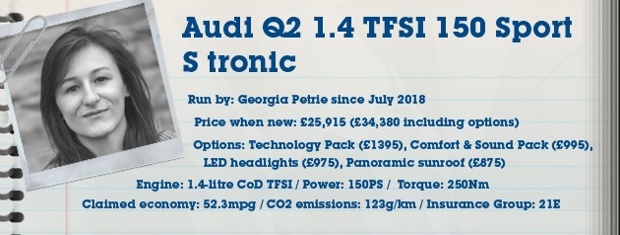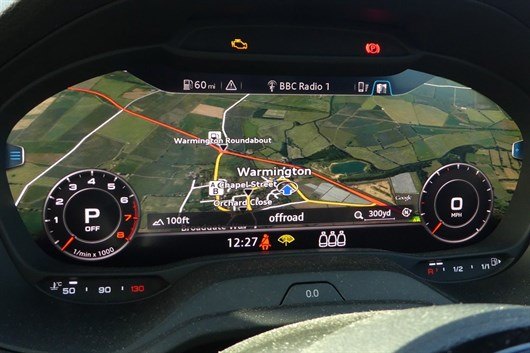Our Audi Q2 arrives...and it's yellow
Our new Audi Q2 arrives, and the colour causes a range of reactions.
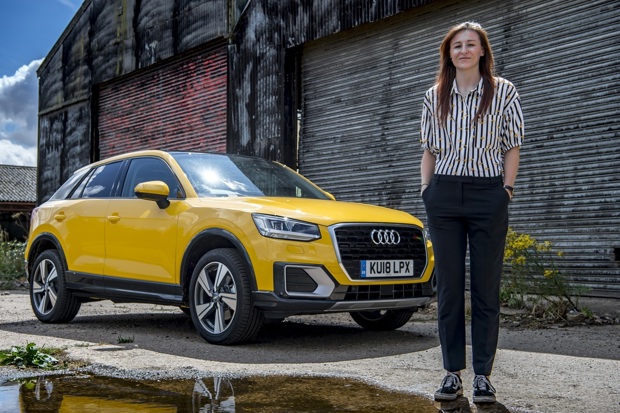
Date: 11 July 2018
| Current mileage: 896
| Claimed economy: 52.3
| Actual economy: 42
Our new Audi Q2 has arrived. And it's yellow, as you may have noticed. This colour choice has evoked a lot more emotion from people than was expected, but more on that in a later update.
We opted for the 1.4 TFSI Sport 150PS model. With the Sport trim, the Q2 gets front sports seats, Navigation, contrast colour bumpers and Audi Drive Select. We then added an S tronic auto gearbox, which took the price to £26,465.
With Vegas Yellow paint (£550), 18-inch diamond-cut alloy wheels for £925 (instead of the standard 17-inch) and LED headlights for £975 - the Q2 is already around £7000 more than the £22,990 base price.
A few more optional extras later (a panoramic sunroof, privacy glass, keyless entry, dual zone climate control, Bang & Olufsen Sound System, virtual cockpit, smartphone interface), and we reach a total of £34,380. Ouch.
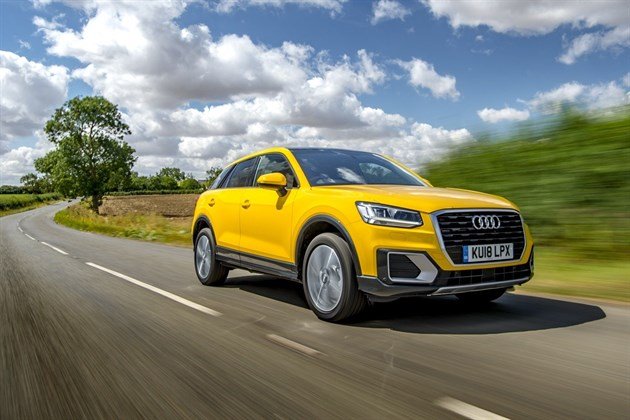
Vegas Yellow is a £550 optional extra...
Oddly, the Audi phone box with wireless charging (which we opted for) is £325, but it won't actually charge an iPhone - like our 6S - without Audi's £40 wireless charging phone case (which we didn't opt for). It feels kind of like bringing a cider to a BBQ and then being charged £40 by your mate to use his bottle opener.
So, is it worth £34k? Well, not on first impressions. It's comfortable, practical, refined and fun to drive - everything you'd expect from Audi. But it's a lot pricier than similarly sized rivals like the SEAT Arona, Renault Captur and Volkswagen T-Roc (we'll let you know how it compares to the latter in a later update).
While the Q2 definitely looks pretty, it's an odd strategy to market this premium-badged, premium-pricetag compact crossover to design-conscious young drivers like myself. After all, insurance is so high for young drivers that there isn't much money leftover for a big monthly finance bill.
Taking this into account, is there any reason then to choose a Q2 over an Audi A3, with which it shares a platform, engines and safety systems? This is yet another question we'll be seeking to answer over the coming months. Watch this space...
To Bristol and back in our Audi Q2
Georgia takes her Audi Q2 on a trip to Bristol, but how does is fare on a long trip?
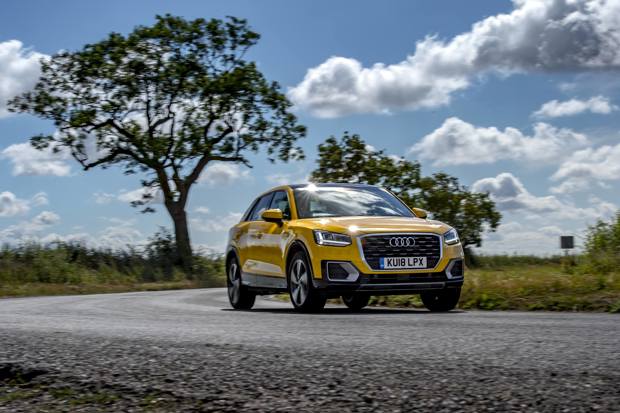
Date: 25 July 2018
| Current mileage: 1429
| Claimed economy: 52.3
| Actual economy: 42.2
This week I took our Audi Q2 to Bristol for a long weekend, which was a three hour trip from Bedford (where we left our dog for his own weekend break). A long trip is always an ideal way to test the limits of a new long termer because passengers love nothing more than to fiddle with every part of a new car to see what it does. At least, mine does.
As there was only two of us heading down south for the weekend, the Q2's 405-litre boot easily offered enough space for the two suitcases we brought with us. The boot is 50 litres larger than the Nissan Juke’s. However, it doesn't quite match up to the 50 litres more you'd get with a Renault Captur.
But, like most crossovers, the boot is usefully square-shaped so it offers a practical, useable amount of space. And that practicality extends to the rear seats too.
While it isn't huge back there, you do get a good amount of space if you sit in the back - so long as the driver and front passenger don't push their seat too far back.
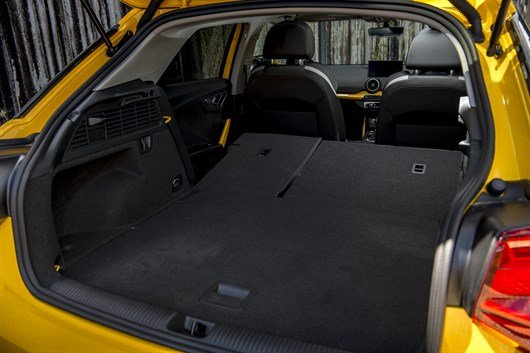
The Q2 has more than enough space for a small family, or just two people.
However, it isn't so nice in the back on a warm day. Returning to the car after a few hours on a scorching hot July day, we found it — as expected — roasting inside. While the front cooled down fairly quickly, the air con didn't reach the rear seat passengers very well, which could make for quite an uncomfortably hot ride.
While it's boring to mention, there's also plenty of useful storage compartments to keep things like bottles and snacks on a long trip to Bristol, or somewhere else that's 150 miles away. And the charging box in the centre console under the middle arm rest doubles as a good place to keep kitkats so they don't melt on a hot day.
Comfort in the Q2 is relatively good, and can be adjusted to different options like Dynamic, Sport, Comfort etc using the Drive Select button. It isn't as comfortable as a Volvo XC40, but it isn't uncomfortable enough to need to get out of the car and stretch mid-trip.
Overall, the Q2 is pretty decent for comfort, as you'd expect with a Volkswagen Group car. If only it had adjustable lumbar support...
Audi Q2 vs Volkswagen T-Roc
Georgia puts our Audi Q2 through its paces against a VW T-Roc.
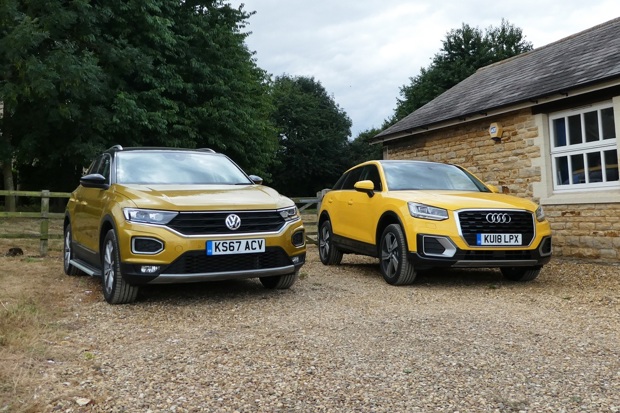
Date: 8 August 2018
| Current mileage: 1993
| Claimed economy: 52.3
| Actual economy: 42.5
The Audi Q2 rides on the same platform as the Volkswagen T-Roc, which it also shares engine options with — so, naturally, buyers are likely to compare the two, so we'll do the same. The T-Roc we're testing is a 1.0-litre 115PS 6-speed manual, compared with our 1.4-litre TFSI Sport 150PS Audi Q2.
But we'll just compare base-spec prices for simplicity, which is £19,000 for the T-Roc and £21,665 for the Q2. The German siblings (and rivals) are very similar crossovers, but which one would we pick?
Both cars are a big departure away from their smaller counterparts (the Golf and A3). While neither are groundbreaking designs — features like panel creases, coloured interior inserts and a generally less boxy bodies certainly make them less boring than we're used to (especially with straight-laced Volkswagen).
The interiors are quite different between our models as well. Where the T-Roc is well-designed and simple with its intuitive layout and touchscreen infotainment system, the Q2 goes for a more luxurious approach. The sporty flat-bottom wheel, squishy dashboard, circular swivelling air vents and virtual cockpit all scream quality. The extras definitely come at a cost (it's Audi after all), but it feels more special. Although both have interior colour inserts, I prefer the Q2's slightly subtler colour scheme.
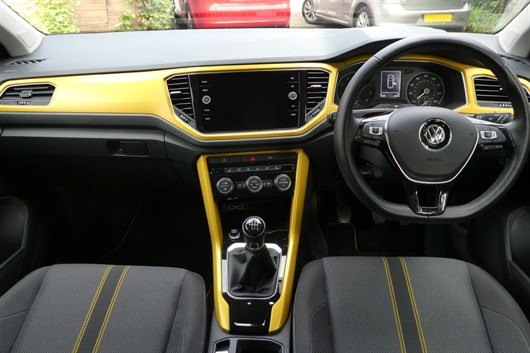
The T-Roc has more personality than the Golf, but the big Gold sections of dash are garish
When it comes to family practicality, the Q2 falls short against the Volkswagen though. Those with small children will be okay, but if you plan to take teenagers or adults around regularly, they'll struggle to be comfortable in the Q2's rear seats over long durations. The roof isn't that high for tall passengers, and the big rear pillar blocks out a lot of light, so — like the Nissan Juke — it can feel a little gloomy in the back.
The Volkswagen crossover also beats the Audi in terms of boot space. With the seats up, you get 40 litres of extra space in the T-Roc, with the seats down you get 240 litres more.
But what about on the road? The T-Roc is very like the Golf — it's comfortable, quiet and handles well. But it doesn't feel that fun. Behind the wheel of the Audi, it's just as you'd expect, a bit nippier and sportier and generally more engaging to drive. It's very slightly less comfortable, but you can engage the Comfort mode in Drive Select if you go for the same options I have.
What you prefer will be dependent on what you want out of your crossover. If you want space and practicality then the T-Roc will appeal to you more. Personally, I prefer the Q2. I've driven it more, of course, but it feels that little bit nicer to drive and it's definitely the nicer car to sit in. But Audi's optional extras will kick up the price a lot more than Volkswagen's, so if you want to save some cash, the T-Roc is a better bet.
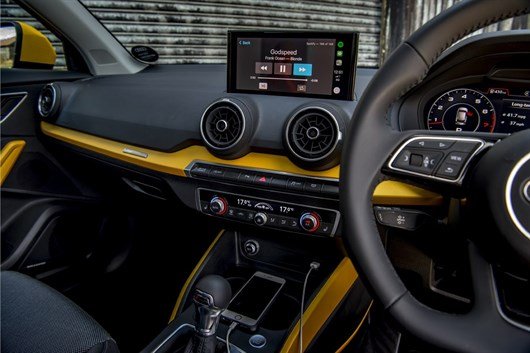
Touchscreens tantrums in our Audi Q2
Georgia begins to find the lack of touchscreen in our Q2 slightly irksome...
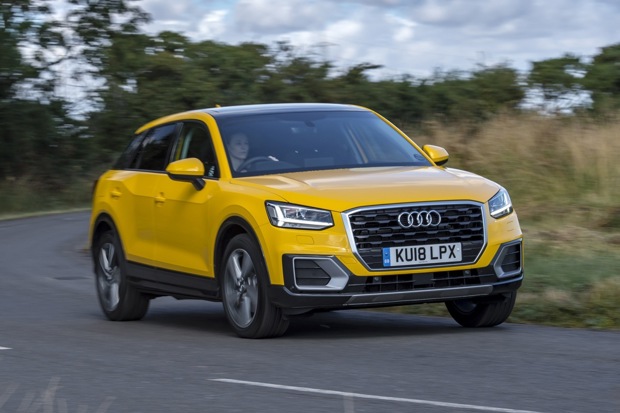
Date: 22 August 2018
| Current mileage: 2372
| Claimed economy: 52.3
| Actual economy: 42.6
The number one issue I've faced over and over again in my Audi Q2 has been the lack of a touchscreen. And, while that may sound very millenial of me, it was a real problem when we came up against a road closure that Apple Maps didn't alert us to.
Usually, we'd just reroute by picking another route option on the screen, but with the Q2 we had to use the spinning dial near the centre console to change a whole host of navigation options on the move - which was only possible (and safe) because I had a passenger there to do it for me.
And, while this shouldn't be an issue for much longer with the release of Apple's iOS 12 coming in September 2018, it's an very irksome situation right now.
For the not-so tech savvy readers, the iOS update finally means those with an iPhone can now use Waze with Apple CarPlay to get (in my opinion) far more useful navigation that alerts you to everything from debris in the road, cars on the hard shoulder, traffic, road closures, safety cameras and police, and a whole host more. This means no more changing Apple Maps routes on-the-go when the fail to alert me to traffic or road closures.
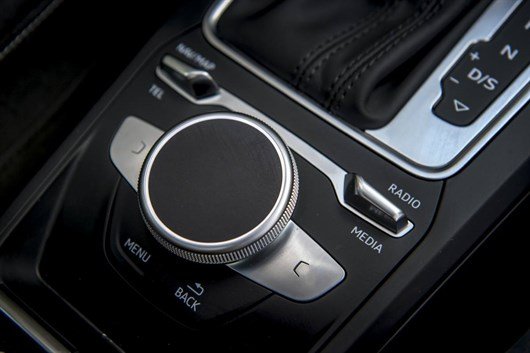
The dial is no match for a touchscreen
And this isn't to say that the infotainment system is bad. It really isn't. But the issue with not having a touchscreen is that it makes you want to just grab your phone to change route directions, skip songs or make calls that you're trying to do with a spinning dial. Which is unsafe and illegal.
But, like Pavlov's dogs, we've all been conditioned through various devices in the form of mobile phones, tablets and even in-car touchscreens to be able to easily do what we want in an instant. So not having a touchscreen is frustrating, especially for the premium price you're paying for the car.
It's legal to use a built-in touchscreen in a car, but drivers can still be charged with careless driving, dangerous driving or driving without due care and attention if the police believe that it affected their standard of driving. So the dial makes sense; you get to keep focus solely on the road instead of looking away momentarily to fiddle with a touchscreen.
But, as a friend mentioned while he watched me angrily trying to use the dial to change routes on Maps, it's probably less safe to use a dial than just tapping a touchscreen once while you drive. Although, obviously, the safest option is to not be distracted at all while in control of a huge metal vehicle going 70mph.
Yellow is the new black, well, not quite
Georgia contemplates the triumphs and tribulations of owning a yellow car.
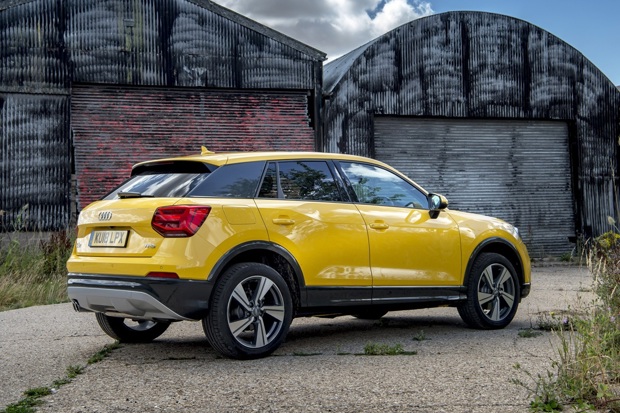
Date: 5 September 2018
| Current mileage: 2744
| Claimed economy: 52.3
| Actual economy: 42.8
As the late Amy Winehouse once sang, we've gone Back to Black. I'm paraphrasing of course, but black is was the UK's favourite car colour in 2017 — beating 2016's favourite colour, white. We're an exciting bunch, aren't we?
Where you'd once see colours like canary yellow, graphite nightmist and desert coral on every British street, many buyers now opt for more conservative colours to guarantee higher residual values — which is why almost 60 per cent of the 2.54 million new cars registered in 2017 were ordered in black, grey or white.
So, is getting a new, yellow car a bit of a radical idea these days? Well, for us, we don't have to worry too much about residuals because our long-term test cars go back home to their manufacturers after six months. But, if I were to actually spend my own money on an Audi Q2, would I still choose yellow?
If I'm being honest, I probably would. In the three months I've had my Q2, I've yet to see another lovely ray of sunshine drive past me. In fact, most of the ones I see are in the chic charcoal colour, which Audi inventively calls Nano Grey metallic. Exciting...
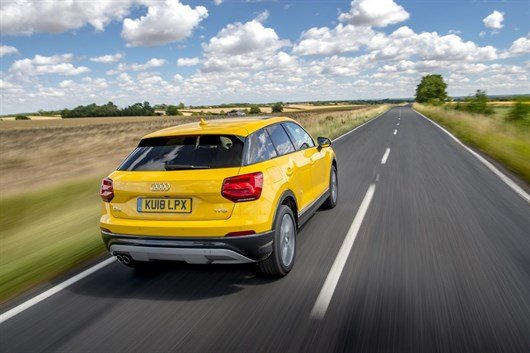
Saying that, though, I'm also yet to get any other Q2 drivers to wave/nod back at me. With my green Skoda Fabia, for example, other Fabia drivers often nodded or waved at me (especially other green Fabia owners). But the Q2 doesn't spark that sense of solidarity. The drivers are all a bit too serious perhaps. Or, like me, trying to figure out the non-touchscreen infotainment system.
Aside from being kind of difficult to keep clean, and attracting all manner of bugs, the yellow Q2 doesn't really yield many issues. It's extremely easy to find in a car park, photographs well and gets all sorts of compliments from unsolicited strangers.
I've had it called everything from wonderful to ghastly, and one reader even said it looked like a sexy minion. Ew. But it gets people talking, and I suppose that's mostly because even if you hate it — it's a nice change of pace amongst the sea of monotonous monochrome you're usually bombarded.
Plus, I regularly get to see kids punching each other in the arm when they see my yellow car drive past. It's the small things that make all the difference.
Is the Audi Q2 really meant to appeal to young buyers?
The Audi ticks all the boxes for young buyers who want a sporty, stylish and premium car. But what's up with the £21k price tag?
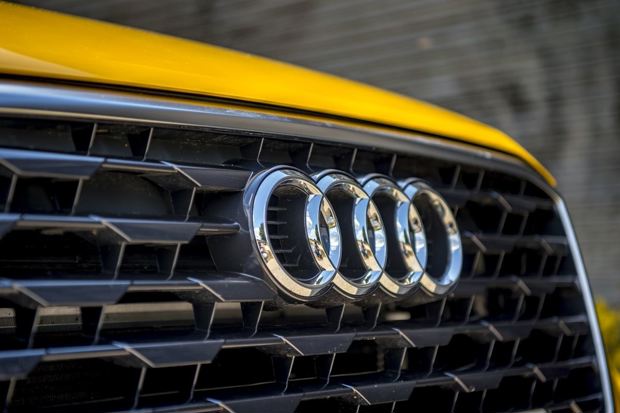
Date: 19 September 2018
| Current mileage: 3659
| Claimed economy: 52.3
| Actual economy: 42.8
The Q2 is designed to appeal to a 'younger audience', which is understandable when you consider some of the unique design traits. The sharper lines, sporty flat-bottomed wheel, range of customisation options (like coloured inserts) and vibrant paint colours (like yellow and orange) definitely give it an advantage over its larger siblings — the Q3, Q5 and Q7.
As a 20-something millenial, the phrase 'younger audience' tends to conjure the same feelings I get when I watch those perfume adverts where a celebrity rolls around in a cocoon of linen sheets, whispering the name Christian Dior or the like — the seller or advertiser doesn't really understand their audience.
My main point being, where would an 18-30 year old (mostly the front end of that age range, in this instance), get £21,000 for a Q2 (base spec SE, 1.0 TFSI 6-speed manual)?
In fact, if we were to add all the things that make the Q2 appeal to young buyers — yellow paint (£575), rear-view camera (£550) and the Audi Sound System (£255) then you've added over £1300 onto the list price. For sports seats and 17-inch alloys as standard, you'd need to get the Sport trim, which starts at £22,710.
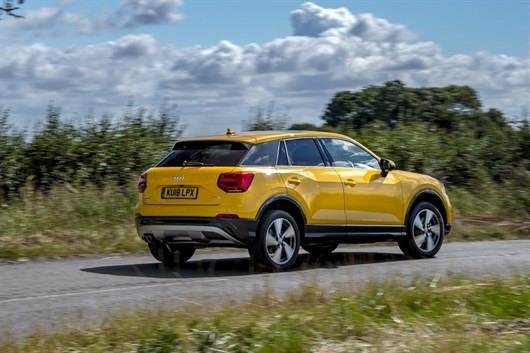
The sloped roof, sharp lines and vibrant colours scream 'hipster millenials in skinny jeans'
But targeting a younger market does at least partially explain the bold (for Audi at least), if somewhat polarising, looks. The sporty appearance, including a roof that gradually slopes downward in a similar fashion to the Range Rover Evoque and the two thick rear-pillars called "blades" (which can be specified in different colours) definitely appeals to younger buyers, even if the price tag doesn't match.
Whether you think it's a looker is up to you. Of course, what will have plenty of appeal is the fact there's an Audi badge on the massive grille.
The lack of rear space compared with larger crossovers also makes it appealing for first or second time buyers that want something slightly bigger than a hatchback. The lower roofline means taller adults can feel hemmed in with their heads touching the roof though.
However, as I've said in previous updates, couples and small families will be fine in the Q2 because there's plenty of space for children and car seats. Just make sure you won't be driving around with lots of people regularly because the rear middle seat can get very cramped when you've got a person on either side of you.
Our summer Sunflower becomes an autumn Acacia
Seasons changing get Georgia thinking about the first three months with her Audi Q2.
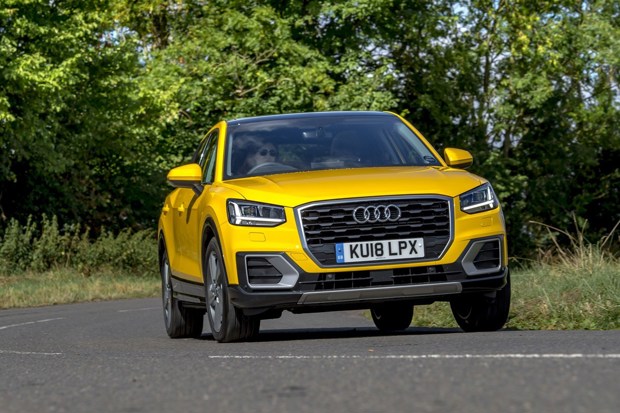
Date: 3 October 2018
| Current mileage: 4001
| Claimed economy: 52.3
| Actual economy: 42.9
Now that I've spent ten minutes finding a yellow flower that begins with an A, we can really get into the point of this review - how am I getting on with our Audi Q2 three months in? As rain and cold winds replace the heat that summer brought with it, I reach the halfway point of running the Q2 (which arrived in July).
Gone are the bugs that clung to my car thinking it was some kind of huge, wonderful, yellow flower — but my enjoyment of the Q2 remains steadfast.
All in all, the Q2 is hard to pick faults with. As with most things, the biggest issue remains the price. As we noted in a previous update, you can get a Volkswagen T-Roc for far less cash, and you get a touchscreen with it — which you don't with the Q2.
The official fuel economy figure of 60mpg isn't accurate under day-to-day driving, as with most cars. I'm getting closer to 42mpg, which isn't terrible for a car of this size. But with petrol sat at around 128ppl in the UK, filling up is a painful experience for my bank account.
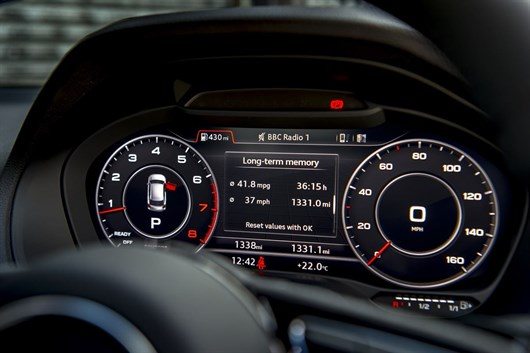
But for the most part, I've enjoyed having the Q2 a lot for these last few months. After all, it's a small crossover with a dash of style and a premium badge. Audi's Virtual Cockpit is also great, but comes as part of the very pricey (£1500) Technology Pack. Ouch.
And it drives very nicely, too. The 1.4 TFSI is an excellent engine; punchy, quiet and smooth (although the tyres can be a tad loud at motorway speeds).
The 405 litres of boot space is plenty for a pushchair if you have a young family, as well as for groceries and the like. My labrador has also taken a few trips to the park in my Q2, so for those with a dog — or two — to ferry around, there's more than enough space.
I'd even argue the Q2 is starting to make me a bit of a crossover convert, having previously protested my preference of hatchbacks for someone like myself — mid-20s with no kids and no desire for the extra space or the cash you pay for it. For me, three months in, it ticks a lot of the boxes I need/want.
Is partial matting the most pointless customisation you can get on a Q2?
Audi has added some partial matting onto the rear pillar for customers who buy a Q2 Special Edition #2. Georgia takes you though the fancy, but pointless, optional extra.
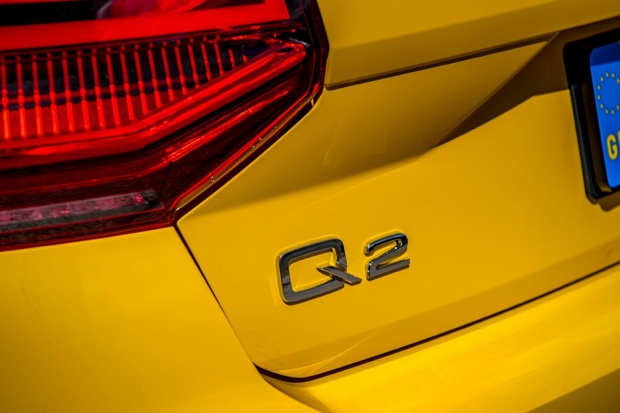
Date: 17 October 2018
| Current mileage: 4740
| Claimed economy: 52.3
| Actual economy: 43
There aren't too many pointless options on your average day-to-day cars these days. While the same can't be said about supercars or the options list of the super wealthy (I'm looking at you, Rolls-Royce umbrella), there aren't too many extras I actually scoff at.
Enter, partial matting on the Q2's carbon fibre rear (C) pillar. Audi is the first car manufacturer, as it proudly states, to offer this optional extra on a the Q2 #2 Special Edition, which adds extra standard kit and some special design features to the standard Q2.
The Audi R8 was the first Audi to feature partial matting, with the process being done by hand when it launched in 2016. It's automated now though, only taking about one minute to stick the thin plastic film onto the panel and then spray it with a fine powder of crushed glass. Fancy, eh?
The extra level of customisation means you can add lettering, logos or photos to your Q2 Special Edition #2's rear pillar.
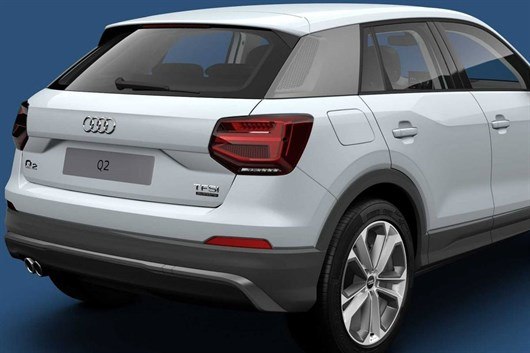
It's hard to spot if you don't know what you're looking for...
As a fan of both childhood nostalgia and Ready Steady Cook, I'd customise my rear pillar with Ainsley Harriet's glorious face to brighten up my fellow commuter's day, but to each their own. I assume most people will add their business logo or the like.
The patented tech involves a system that sprays the panel under a vacuum, which removes a few thousandths of a millimeter from the top layer of clear lacquer. The #2 Special Edition of the Audi Q2 in the photo above features a pattern of crosses.
Each painted surface in the interior or exterior of the car can get this treatment too. "With this process, we have gained a great advantage over our competitors," says Dr. Erhard Brandl, Head of Sheet Metal/Painting Technology Development. That's a lot of confidence for what is essentially sandblasting parts of your car.
The missed trick here, to me, seems to be that rather than focusing on an issue that exists, Audi seems to just be adding fancy extras for fancy extras' sake. And by this I mean, rather than thinking about how to improve the massive blindspot the chunky rear pillars create when I'm trying to see through my rear window at a junction, they've just added some customisable pixels onto it. Interesting...
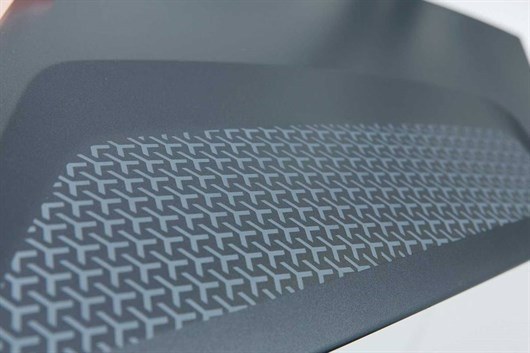
Does the new Audi Q3 make our Q2 look dated?
Th new Audi Q3 is newer and nicer than the Q2, so why does it only cost a touch more than our Q2?
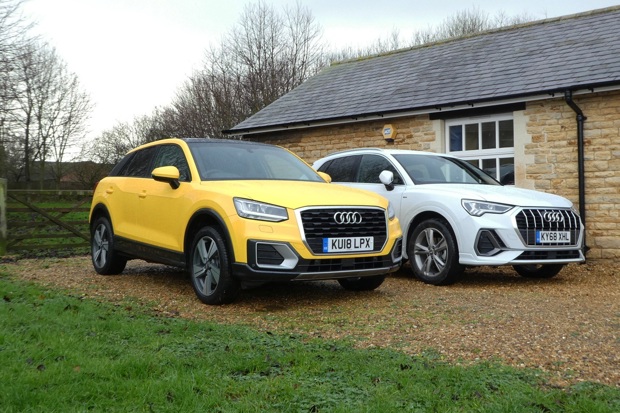
Date: 28 November 2018
| Current mileage: 2292
| Claimed economy: 52.3
| Actual economy: 42.7
In 2016 our David went to drive the Audi Q2 in Switzerland (fancy, eh?), which was new at the time. He wrote all about how it made the ageing Q3 feel outdated here. Basically, the shiny new Q2 made the Q3 feel plastic and clunky - the Q2 felt more up to date inside, it was cheaper to buy and it came with more tech.
But things changed when Audi recently launched its all-new Q3, which now makes my Q2 feel a bit old. The Q2 isn't archaic by any means; it's packed with tech (including the Virtual Cockpit we wrote about), feels premium inside and still strikes us as a car for 'young buyers'. But the Q3 blends the edginess of the Q2 with the sensible Q5, meaning it looks excellent - and appeals well to families.
Before the new model launched, the Q3 was the grandad of the Audi range, having been first launched in 2011. It was in dire need of an update, and it got one. Spoiler alert: it's very good. Annoyingly good, in fact. Getting back into my Q2 after a week of tearing around in the Q3 felt a bit like stepping back in time. That time only being 2016, but still, I was surprised by quite how much the Q3 changed my perspective of the Q2.
While the Q2 is smaller, and definitely appeals to a different market, is begs the question: why is the new Q3 bigger, nicer and newer than the Q2 while also being barely more expensive? Let's get into the nitty gritty of it.
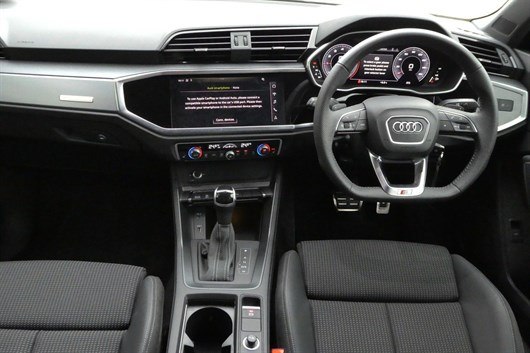
This is the new Q3's interior, the Q2's interior is at the bottom of this update
So, pound for pound, the Q3 is a better deal. It's that simple. We summarised our options in our first update, but it looks something this: our 1.4 TFSI Q2 Sport 150PS model with an S tronic auto gearbox is £26,465. Extras like 18-inch diamond-cut alloy wheels, panoramic sunroof, keyless entry, dual zone climate control, Bang & Olufsen Sound System and Virtual Cockpit brought the Q2 to £34k. Yeah...
The Q3 35 (1.5) TFSI 150PS S-line S tronic (auto) is £33,260. Plus options that include ambient interior lighting, Virtual Cockpit (£250), heated front seats, electric folding mirrors, Audi sound system and a few others - it comes to £37,565. Obviously this is about £3k more than the Q2, and if you want a crossover then you shouldn't opt for a pricier, larger Audi simply for value.
However, if you're trying to choose between the two (if you have a growing family, for example), I'd argue the Q3 is a better option. I really enjoy driving my Q2, and I'd even say I prefer some of the design choices too (the circular air vents in my Q2 are nicer than the integrated vents in the Q3's dash, in my opinion). But the Q3 not only offers more space than the Q2, but also more rear passenger room than the previous Q3. It also comes with a touchscreen infotainment system, which my Q2 doesn't (!), and other newer features within the cabin.
The 1.5-litre petrol also uses cylinder on demand technology to deactive two cylinders and provide better fuel economy under light loads. It could be argued that a cheaper Q2 (without all the options I added) would be a better deal than the Q3, but with less options the Q3 still offers a newer and nicer driving experience. The 35 TFSI isn't the most fun engine, but it's very decent around towns and on country roads - making it the ideal family car with more standard options than the Q2.
Is Audi's virtual cockpit worth the money?
Georgia likes the Virtual Cockpit in the Q2, but is it worth £1400?
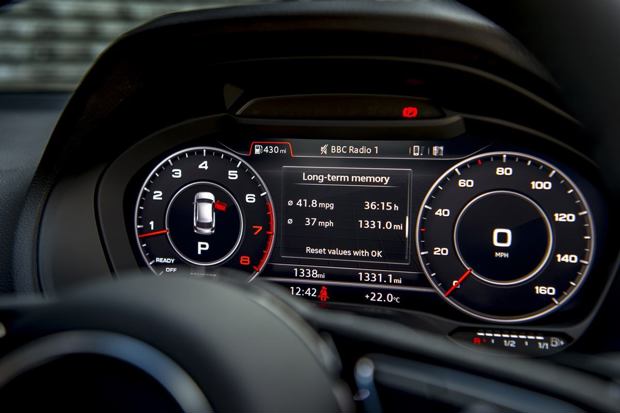
Date: 31 October 2018
| Current mileage: 5291
| Claimed economy: 52.3
| Actual economy: 43.1
Does the 1.4 TFSI cut it in our Audi Q2?
The 1.4 TFSI in Audi's lineup has been replaced by the 1.5 TFSI (35 TFSI), but which engine would Georgia opt for?
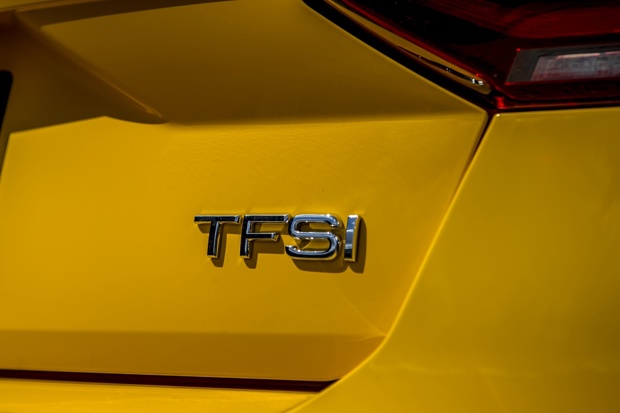
Date: 14 November 2018
| Current mileage: 5792
| Claimed economy: 52.3
| Actual economy: 43.1
Like most manufacturers, Audi has moved towards its downsizing turbocharged petrol engines in the last few years — meaning the 1.4-litre engine in our Q2 boasts better fuel economy and improved performance in lower gears than bigger, making them more enjoyable to drive around towns and cities.
The 150PS of our 1.4 offers plenty of punch and refinement, while achieving a decent 43mpg fuel economy traversing the country roads of my commute, which - admittedly - isn't the urban environment the Q2 is aimed at.
But you won’t find a 1.4-litre engine under the bonnet of a brand new Q2, because Audi has replaced the 1.4-litre engine with the 1.5 TFSI (also known as a 35TFSI) in its lineup.
The slightly larger turbocharged 1.5-litre four-cylinder achieves the same 150PS and 52.3mpg official combined fuel economy as our 1.4 TFSI, but it's ever-so-slightly smoother to drive and cheaper to run. For the most part, there's very little noticeable difference between the engines.
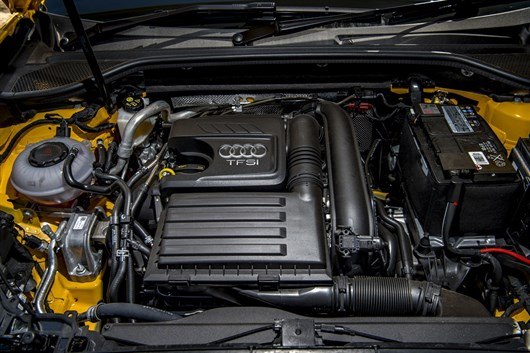
Look, it's an engine!
Although, if you're buying a used Q2 then knowing a bit about the 1.4-petrol is a necessity. Before the 1.5, the Q2 came with two petrol options, the 1.0-litre (30 TFSI) and the 1.4. Diesel drivers get the choice of a 1.6 or 2.0 TDI, but we'll concentrate on the petrols for now.
For urban drivers who spend most of their time driving around towns, the 1.0 is a great choice. The 1.0-litre is also £2000 cheaper than the 1.4 TFSI. If, like me, you do a lot driving at motorway speeds - the 1.4 TFSI makes more sense, especially if you'll have passengers with you most of the time.
The engine in our Q2 is enjoyably and sporty, yet very refined and smooth. It's especially fun in Dynamic mode, which is one of the options (along with Comfort, Auto, Individual and Eco) on the Audi Drive Select menu - which comes as standard on Sport trim.
The S-Tronic is also great paired with our 1.4 TFSI engine, although it does have a bit of a habit of hesistating when you try to accelerate from standstill. This issue is more prevelant in some modes than others, i.e. it happens more often when going uphill in Auto than in Dynamic because the gearbox struggles to know if it needs to be in second or third gear.
Our Audi Q2 is heading home, and we're sad to see it go
It's time to say goodbye to our lovely yellow Q2, and we'd be lying if we said we wouldn't miss it.
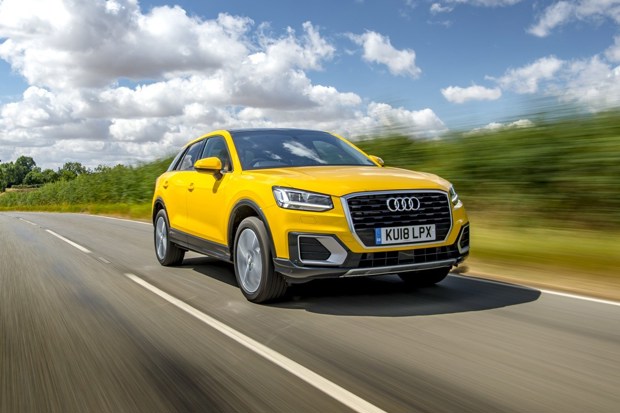
Date: 28 November 2018
| Current mileage: 6285
| Claimed economy: 52.3
| Actual economy: 43.3
The time has come to bid farewell to the Audi Q2 that we've been running for six months. And we're going to miss it. Apart from a few minor gripes, the Q2 has served us well. It's practical, stylish and fairly economical - if not a bit expensive.
So, the good stuff: it returns around 43.0mpg, it's stylish and packed with tech like the virtual cockpit and it's reasonably practical for a small family. My Q2 looks great in yellow (although that's a matter of opinion) and it suits broken country roads just as well as long stretches of motorway.
And the bad? It's pricey and - as we pointed out in this update - it's starting to feel a tad dated. In the motor industry, cars age quickly - and nothing makes that more obvious than when a manufacturer launches a new model.
The Q3 not only offers more space than the Q2, but also more rear passenger room than the previous Q3. It also comes with a touchscreen infotainment system, which my Q2 doesn't (!), and other newer features within the cabin. If you're trying to choose between the two (if you have a growing family, for example), I'd argue the Q3 is a better option.
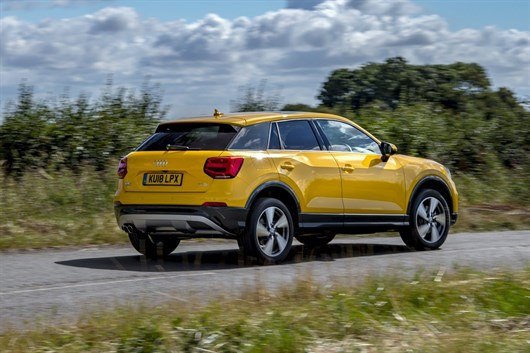
Not the best colour for residual values...
In our Q2 vs T-Roc update, we mentioned that the T-Roc is more practical for families because of the extra space it offers. Although, we think the Q2 is a bit nippier, sportier and generally more engaging to drive.
The T-Roc is the smart option, being cheaper and more practical, but we prefer the Q2. After all, it's a small crossover with a dash of style and a premium badge.
The Q2 is targeted at young buyers - yet, the price still pushes it beyond what I think most early 20-something year olds (like myself) would be able to afford. On Audi's Solutions PCP scheme, for a 35 TFSI 150 PS S tronic, you'd be paying £319 per month for four years with a £6164 deposit. Representative APR is 5.9% and final payment would be £14,308...
You can obviously opt for smaller engines, lower specs and less optional extras - but isn't Audi about luxury? We like it regardless, and we'll definitely miss it when we move onto our new long-termer. Stay tuned to see what we'll be driving for the next six months. It's another crossover, but very different from our Q2.
Read our full review of the Audi Q2


